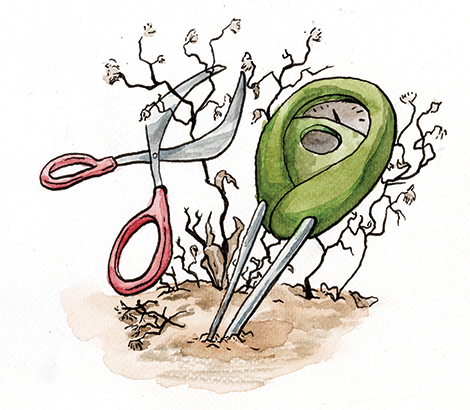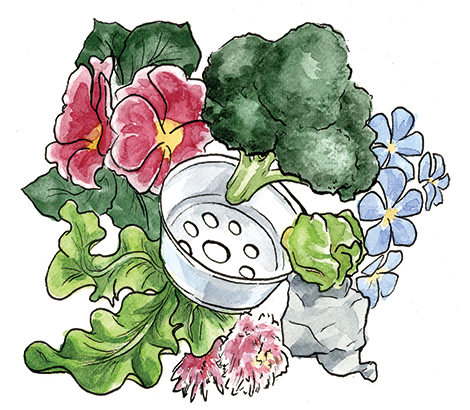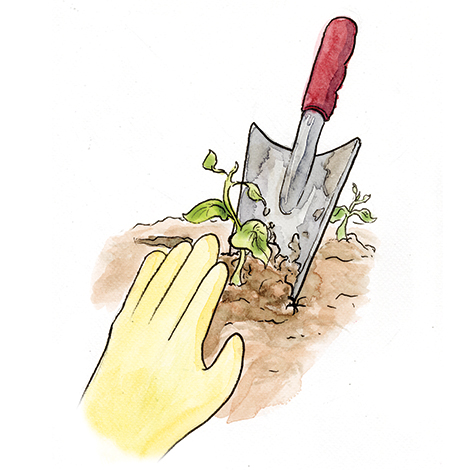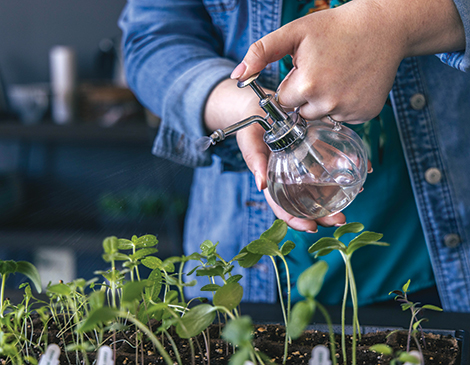It happens every year, on that late-winter day when the sun melts the last traces of snow and warms the ground beneath enough that you can actually smell its earthy freshness. The grass gets greener, spring rains move in and even those who have never gardened before experience a sudden desire to dig in the dirt and grow something.
From fresh vegetables and herbs to annuals and perennials in a rainbow of blooms, Greater Cleveland's gardening pros are prepped and ready to help those with an eager green thumb find their starting point. Holden Arboretum horticulturist Sandi Cesorov writes on their website that March is the perfect time to begin indoor seeding for fruit and vegetable gardens, and that the prime time window to get seeds started is March 1-15.
While the start of the growing season in Northeast Ohio is still weeks away, there are plenty of things you can do to prepare the soils, flower beds and seedlings for the spring and summer.

Illustration by Emily Zhang
1. Clean up Those Beds
Dawn Gerlica, senior horticulturist at Holden Forests & Gardens, recommends waiting to clear any dead plant material until temperatures consistently remain above 50 degrees. “Many species of bees lay their eggs at the end of the growing season in the stems of our flowers, and many butterflies and moths overwinter as eggs, larvae or pupae in the leaf litter around the base of the plants, waiting for the right temperatures to emerge,” she says.
2. Test the Soil pH
Noelle Clark Akin, manager of training and education for Petitti Garden Center, says do-it-yourself kits are available at garden centers. “You’re looking for any unbalanced, either very acidic or very basic areas,” she says. The ideal range: between 6.0, which is slightly acidic, to 7.0, which is neutral. To achieve it, apply an appropriate commercially prepared product according to manufacturer’s instructions (Akin recommends Lightning Lime).
3. Help Them Grow
Composting is an all-natural way to give plants the nutrients they need without wasting food resources. According to Rust Belt Riders, home goods and foods such as paper towels, egg shells, citrus fruits and rice can all go in a compost bin to be used as fertilizer for gardens. Gerlica suggests waiting to apply chemical fertilizers until plants are actually in the ground. “You don’t want it to all wash out with the spring rains,” she says.

4. Start Seeds Indoors
Akin recommends delaying the start of “hot crops” such as tomatoes, peppers and eggplant, along with flowers such as marigolds and zinnias, until late March or April. She suggests planting two to three seeds in a sterile container with drainage (a yogurt container with holes punched in the bottom that has been washed in hot, soapy water, then rinsed in a 10-percent bleach solution). Gerlica recommends using the Farmer's Almanac for further planting guidance.
5. Place in a Sunny Spot
Place the containers in a warm, sunny spot that remains reasonably warm at night. “Seeds want temperatures that you would be comfortable in” – generally, 70 to 75 degrees, Gerlica says. Keep the soil moist, but not sopping wet. “Every time [the soil] dries out, they’re going to lose more roots,” she says. Once the plants are ready to go out into the sunny weather, Akin advises the ground you plant in should be firm and dry enough to walk on without leaving any footprints.

6. Transition Plants Outside
According to Akin, a plant can transition easier to the outdoors after it has developed two or more leaf sets. Begin the transition by moving the plants to a window in an unheated garage during the day, then returning them to the house at night, for a week or so. Cold crops and hardy early bloomers can begin their transition from late March to early April. Be
prepared to cover the plants if winter weather returns.




